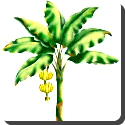 Banana — Banana is the common name for a fruit and also the herbaceous plants of the genus Musa which produce the commonly eaten fruit. They are native to the tropical region of Southeast Asia and Australia. Today, they are cultivated throughout the tropics.
Banana — Banana is the common name for a fruit and also the herbaceous plants of the genus Musa which produce the commonly eaten fruit. They are native to the tropical region of Southeast Asia and Australia. Today, they are cultivated throughout the tropics.
Banana plants are of the family Musaceae. They are cultivated primarily for their fruit, and to a lesser extent for the production of fibre and as ornamental plants. As the bananas are mainly tall, upright, and fairly sturdy, they are often mistaken for trees, when the truth is the main or upright stem is called a pseudostem, literally meaning “fake stem”, which for some species can obtain a height of up to 2–8 m, with leaves of up to 3.5 m in length. Each pseudostem would produce a bunch of yellow, green, or even red bananas before dying and being replaced by another pseudostem.
The banana fruit grow in hanging clusters, with up to 20 fruit to a tier (called a hand), and 3-20 tiers to a bunch. The total of the hanging clusters is known as a bunch, or commercially as a “banana stem”, and can weigh from 30–50 kg. The fruit averages 125 g, of which approximately 75% is water and 25% dry matter content. Each individual fruit (known as a banana or ‘finger’) has a protective outer layer (a peel or skin) with a fleshy edible inner portion. Typically, the fruit has numerous strings (called ‘phloem bundles’) which run between the skin and the edible portion of the banana, and which are commonly removed individually after the skin is removed. Bananas are a valuable source of vitamin B6, vitamin C, and potassium.
Bananas are grown in at least 107 countries. In popular culture and commerce, “banana” usually refers to soft, sweet “dessert” bananas that are usually eaten raw. The bananas from a group of cultivars with firmer, starchier fruit are called plantains, and are generally used in cooking rather than eaten raw. Bananas may also be dried and eaten as a snack food. Dried bananas are also ground into banana flour.
Although the wild species have fruits with numerous large, hard seeds, virtually all culinary bananas have seedless fruits. Bananas are classified either as dessert bananas (meaning they are yellow and fully ripe when eaten) or as green cooking bananas. Almost all export bananas are of the dessert types; however, only about 10-15% of all production is for export, with the U.S. and EU being the dominant buyers.
Bananas come in a variety of sizes and colors when ripe, including yellow, purple and red. Bananas can be eaten raw though some varieties are generally cooked first. Depending upon cultivar and ripeness, the flesh can vary in taste from starchy to sweet, and texture from firm to mushy. Unripe or green bananas and plantains are used for cooking various dishes and are the staple starch of many tropical populations. Banana sap is extremely sticky and can be used as a practical adhesive. Sap can be obtained from either the pseudostem, the fruit peelings, or the from the flesh.
 Kids Portal For Parents India Kids Network
Kids Portal For Parents India Kids Network






